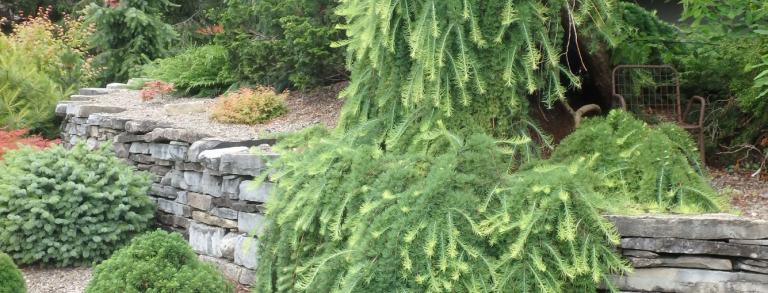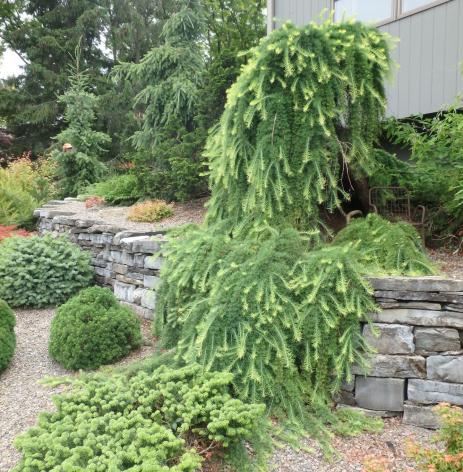I’ve tried to describe the three outstanding gardens featured in our pre-conference day trip. And where words may fail, the photos will serve to illustrate and hopefully pique your interest enough to join us on this bonus excursion on Thursday, June 18th.
Garden with a View: the Gardens of Donna and Jim Kraft
The Kraft home and garden overlooking Crooked Lake has always been about the view. Donna and Jim’s first undertaking was to tame their sloped country property with a series of inviting stone terraces. The planting beds this created were soon filled – in Donna’s words, too filled – with beautiful flowers and unique specimen trees. So, as avowed plant collectors are wont to do, the Krafts created massive new perennial beds in what Donna calls overflow areas, where the grade is flatter. These beds remain today with wonderful species peonies, woodlanders, and more.
Donna’s interest in rock garden plants has grown naturally over time. Says Donna, “Initially, it was about the dwarf forms of familiar cultivars. That evolved into exploring the proper growing conditions that allowed them to thrive rather than just survive. It soon became apparent that troughs were a great way to group unique plants with similar needs.“
Over time, maintenance on such steep terrain became an issue. When Donna was introduced to dwarf conifers and pendulous plants, not only did she see a solution, she also got hooked on their beauty and diversity. However, she comments, “The love of flowers doesn’t subside in the face of adversity,” it merely means she has had to become more selective.
Strolling through the garden, one can appreciate the carefully sited collection of conifers. The young miniatures and dwarfs are complemented by mature, often pendulous or gnarled specimens, amidst strategically placed feather rock tumbles and troughs. “I’ve created more places to pause and observe those small alpine plants which are the perfect companions to young dwarf or miniature conifers,” Donna observes, “They play so well together.”
Small is Beautiful: the Gardens of Dianne and Dan Bordoni
Dianne Bordoni has a penchant for small plants, which just happens to match perfectly with her collector mentality and her smallish suburban lot outside of Syracuse. The yard was vastly overgrown with out-of-control shrubs when she and her husband moved there in 1985. An old yew, now grown to tree-like proportions, was one of the few plants to escape the chain saw and today has become a focal point. Dwarf and miniature conifers allow her to maximize the variety of plants and satisfy her plant lust. Purchasing them when they are small means they are much more economical and allows Dianne the delight of watching them grow. In her garden, you will find both mature conifers – the advantage of residing here for 35 years – and those recently planted.
What she has created is a harmonious landscape of green. “If you only have a green palette, you start noticing the many shades of green.” But what you also notice about her garden is how she is so effective at layering, varying textures, and utilizing spaces big and small. Choice perennials and Japanese maples introduce color. Right plant, right place is her mantra.
Many areas of the garden have deep familial meaning. There are plantings to mark births, deaths, and friendships. The loss of an old tree is marked with a seating area. The pond was sneakily built by her and then-eight-year-old grandson when her disapproving husband was away for the weekend.
Dianne loves to share her garden with fellow plant collectors who love to talk plants and cultivation, who understand the challenges of nature, and who can admire choice specimens.
Pagodahill: the Gardens of Michael Brennan and Robert Moss
When you own an 18-acre rural property and you’re Michael Brennan, it’s easy to think big when it comes to gardening. He and his partner have lived here for 21 years, so where did they begin?
Spoken like a true professional (he is, in fact, a professional landscape designer), Michael confesses, “I did lay out my gardens on paper and gradually they have evolved. Defining areas early on is important. Being outside inspires me.” Adding, “I do like theme gardens. “
What has evolved includes a 60-foot (18 m) locust pergola for roses and clematis, a formal perennial garden backed by a thirty-foot (9 m) hot garden, a large raised-bed vegetable garden that has an ornamental feel, and a shade and shrub border featuring chartreuse foliage and blue and white flowers. A small pond just outside the patio at the back of the house adds sound, dimension, and a touch of whimsy to a yellow-themed garden. Meandering pathways allow access into the wilder terrain of meadow, woodland, and hillside, to reveal specimen trees in unexpected places.
Clematis is one of Michael’s favorite plants, “I find them fun and challenging to grow. I also love plants that self-sow, like verbascum, Verbena bonariensis, and feverfew.”
Michael is very passionate about the Garden Conservancy, an organization that Frank Cabot founded in 1989. “I worked for a woman who was involved with Garden Conservancy from its beginning. She had a wonderful estate in Bedford, New York and was open in the first year of the Open Days program. I saw what pleasure people got out of having the opportunity to visit private gardens and thought, someday I want to be part of this.” Today he serves as a Regional Representative and has opened his garden not just on Open Days with the Conservancy but to many gardening groups, including ours. He has certainly embraced its mission of “sharing outstanding American gardens for the inspiration and education” of others.
And why has he named his place Pagodahill? The property is named for the Pagoda dogwood, Cornus alternifolia, an Eastern North American native, that proliferate on this hilltop bit-of-paradise.


